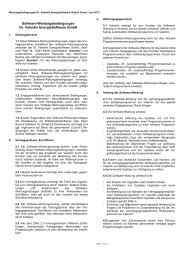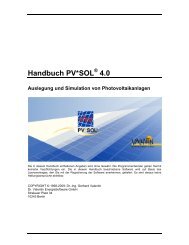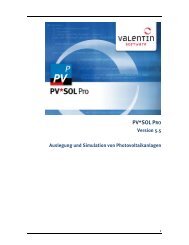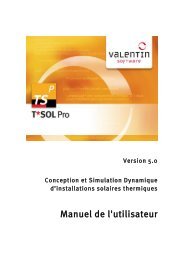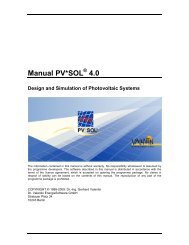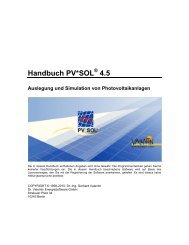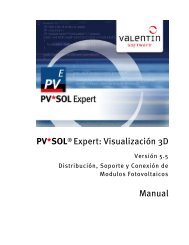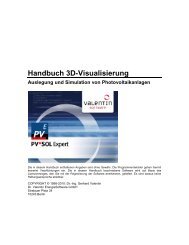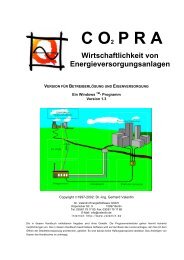Manual T*SOL basic 5.0 - Valentin Software
Manual T*SOL basic 5.0 - Valentin Software
Manual T*SOL basic 5.0 - Valentin Software
You also want an ePaper? Increase the reach of your titles
YUMPU automatically turns print PDFs into web optimized ePapers that Google loves.
User <strong>Manual</strong> <strong>T*SOL</strong> 7 System Definition<br />
Gdiff Diffuse solar irradiation striking a tilted surface<br />
TCm Average temperature in the collector<br />
TA Air temperature<br />
fIAM Incident angle modifier<br />
After deduction of optical losses (conversion factor and incident angle modifiers), a part of the absorbed<br />
radiation is lost through heat transfer and radiation to the environment. These losses are described by<br />
the heat transfer coefficient.<br />
The heat transfer coefficient k states how much heat the collector releases into the environment per<br />
square meter of active solar surface and temperature difference between the average collector<br />
temperature and the environment in degrees Kelvin.<br />
It is split into two parts, the simple and the quadratic part. The simple part ko (in W/m²/K) is multiplied by<br />
the simple temperature difference, the quadratic part kq (in W/m²/K²) by its square. This gives rise to the<br />
efficiency parabolae usually stated. Und? Relevance?<br />
The specific heat capacity states the amount of heat per square meter of active solar surface that the<br />
collector, including its heat transfer medium content, can store at a temperature increase of 1 Kelvin. It is<br />
stated in Ws/m²K. This decides how quickly the collector reacts to the irradiation. The influence of this<br />
value is only significant for relative small pipeline networks, as the capacity of the pipeline network<br />
otherwise takes priority.<br />
After leaving the dialog by clicking OK, the system schematic view is updated with the type of collector<br />
selected.<br />
The SRCC box indicates whether this collector has been tested according to the Solar Collector<br />
Certification Program and that the simulation therefore uses different collector temperatures,<br />
respectively.<br />
7.3.1.2 Collector – Optical Losses<br />
S ystem Definitions > Flat-Plate / Tube Collector > Losses / Optical Losses<br />
Image: Calculation of optical collector losses of a<br />
tube collector<br />
The conversion and incident angle modifiers determine the optical losses, i.e. how much of the irradiated<br />
energy is lost through reflection on glass and the absorber. The remainder is absorbed by the collector.<br />
The conversion factor(in %) states amount absorbed with irradiation vertically to the collector surface<br />
area.<br />
Dr. <strong>Valentin</strong> Energie<strong>Software</strong> GmbH page 54 / 104



